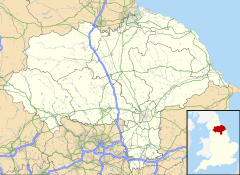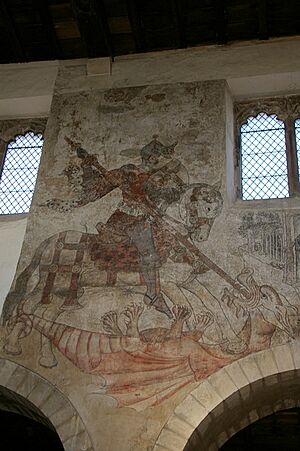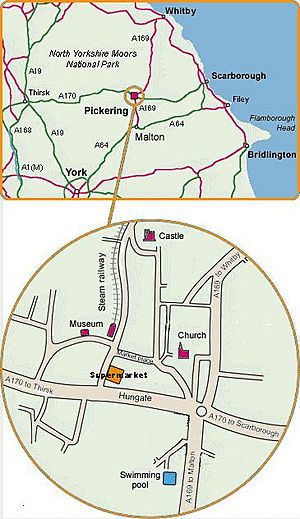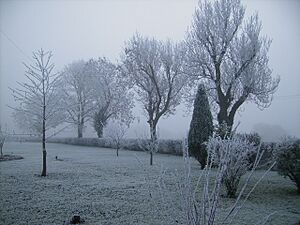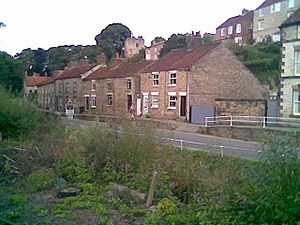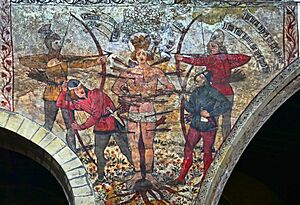Pickering, North Yorkshire facts for kids
Quick facts for kids Pickering |
|
|---|---|
 Pickering Market Place |
|
| Population | 6,830 (2011 Census) |
| OS grid reference | SE797838 |
| • London | 195 mi (314 km) S |
| Unitary authority |
|
| Ceremonial county | |
| Region | |
| Country | England |
| Sovereign state | United Kingdom |
| Post town | PICKERING |
| Postcode district | YO18 |
| Dialling code | 01751 |
| Police | North Yorkshire |
| Fire | North Yorkshire |
| Ambulance | Yorkshire |
| EU Parliament | Yorkshire and the Humber |
| UK Parliament |
|
Pickering is a lively market town in North Yorkshire, England. It sits right next to the beautiful North York Moors National Park. Historically, it was part of the North Riding of Yorkshire. The town is located at the bottom of the moors, looking out over the Vale of Pickering to the south.
Pickering is a popular spot for visitors. People love to see the Pickering Parish Church with its amazing medieval wall paintings. They also visit Pickering Castle, ride the North Yorkshire Moors Railway, and explore the Beck Isle Museum. Nearby towns include Malton, Norton-on-Derwent, and Scarborough.
Contents
- History of Pickering
- How Pickering is Governed
- Geography of Pickering
- Climate and Weather
- Flooding in Pickering
- Population of Pickering
- Economy and Jobs
- Culture, Media, and Sports
- Places to Visit in Pickering
- Religion in Pickering
- Events in Pickering
- Transport in Pickering
- Education in Pickering
- Arms
- See also
History of Pickering
Early Days and Settlements
Pickering was a great place for early settlers to live. It was located on the edge of a large lake at the end of the last Ice Age. This spot offered many natural resources. People could find wood, stone, wildfowl, game, fish, fresh water, and good soil. An important route from the coast also passed through here, where a stream could be easily crossed.
There is proof that Celts and Romans lived in the areas around Pickering. However, not much remains of their settlements in the town itself. The town likely existed during the Anglo-Saxon period. The Domesday Book shows that Pickering had lots of land for farming, meadows, and large woodlands. The town probably grew bigger to serve the Norman castle built later.
After the Norman Conquest
After 1066, when William the Conqueror became King of England, Pickering and its surroundings became property of the crown. A castle and a church were built around this time. Kings from the Middle Ages sometimes visited the area. In 1267, King Henry III of England gave Pickering Castle and its lands to his youngest son, Edmund. Later, it passed to Henry, Duke of Lancaster, who became King Henry IV of England. Since then, it has always belonged to the king or queen.
By 1598, Pickering had several streets, including East Gate and West Gate. Many small, old houses were built, some with thatched roofs. The town's market place had stocks (for punishment), market stalls, and a market cross. Even though the castle started to fall apart, the town continued to grow. During the English Civil War, soldiers stayed in Pickering. They damaged the church and castle, and there was a small fight in the town.
In the 1650s, George Fox, who started the Quakers, visited Pickering to preach. Also, Nicholas Postgate, a Catholic martyr, lived in Pickering for a while before he was executed in York in 1679.
Growth in the 18th and 19th Centuries
Pickering became a busy market town and a center for agriculture. It had watermills and many inns. It was also important for mail coach travel and trade. For a long time, the main stream, Pickering Beck, was used as an open sewer. This continued until the early 1900s.
Many people in Pickering joined Non-conformist religious groups. John Wesley, a famous preacher, visited the town many times between 1764 and 1790. The Quakers had meetings in a cottage before building their Meeting House in 1793. The Pickering Methodist Circuit was formed in 1812.
In the 19th century, these non-conformist groups grew even more. Both Wesleyan and Anglican schools were in the town by the mid-1800s.
The Whitby and Pickering Railway opened in 1836. At first, horses pulled the trains, but steam locomotives were used from 1847. The town also got a local Health Board in 1863. A Gas and Water Company provided gaslight and piped drinking water. Shops started to have glass windows to show off their goods.
Pickering in the 20th Century
By 1901, Pickering had 3,491 people, and by 1911, this grew to 3,674. There were over 60 shops. The growth of non-conformist groups, especially Methodism, led to a strong Liberal political tradition in Pickering.
In 1901, a Catholic priest named Fr Edward Bryan came to Pickering. He started a school and a parish. In 1911, St Joseph's Church was built, designed by architect Leonard Stokes. It has a special font by the famous sculptor Eric Gill.
An old mill was turned into the Memorial Hall in 1922. This was to remember the Pickering men who died in the First World War. This hall is now a modern community center. The Castle Cinema opened in 1937. Electricity had arrived in town a few years before.
From 1920 to 1950, Pickering's role as a farming market town declined. The population fell after 1951. The closure of the railway in 1965, as part of the Beeching cuts, was a big loss for the area.
However, the town's economy improved in the following decades. More people had cars, which led to more tourism. The reopening of the North Yorkshire Moors Railway as a steam railway helped a lot. Also, the TV show Heartbeat was filmed on the nearby moors, bringing more visitors. By 1991, Pickering's population was 6,269.
How Pickering is Governed
Local and National Representation
The person who represents Pickering in the UK Parliament is Kevin Hollinrake (from the Conservative Party). Before the 2010 general election, Pickering was part of the Ryedale constituency. Due to changes in boundaries, it is now in the new Thirsk and Malton constituency.
Pickering has two electoral wards: East and West. The total population of these wards is the same as the town's population. From 1974 until 2023, Pickering was part of the Ryedale district. Pickering is one of the few places in the UK that has a Liberal Party councillor on the North Yorkshire Council.
Geography of Pickering
Where Pickering is Located
Pickering is located where two main roads meet: the A170 road, which connects Scarborough and Thirsk, and the A169 road, which links Malton and Whitby. The town stretches across a wide area. To the south are the low-lying Ings and Low Carrs, and to the north is higher, sloping ground topped by the castle.
The town is built where the older limestone and sandstone rocks of the North York Moors meet the glacial deposits of the Vale of Pickering. The limestone forms the hill where the castle and higher parts of town are. Pickering Beck is a stream that flows through the center of town from north to south. It starts on the moors and flows through Newton Dale before reaching Pickering. The beck can flood when there is very heavy rain, affecting areas close to the stream. The town center is east of the beck, but the population is split almost evenly between the east and west sides. Pickering grew around the old Market Place, but most houses are now in newer areas off the A170 road.
Land and Landscape
North of Pickering are the high moorlands of the North York Moors. These moors rise from about 160 feet (49 meters) at their southern edge to over 1,410 feet (430 meters) on Urra Moor. Many south-flowing streams, including Pickering Beck, cut through the moors. Most of the moorland is made of Jurassic sandstone, with some gritstone on the highest hills.
To the south, these rocks are covered by oolitic limestone. This forms flat-topped hills with a steep slope to the north and gentler slopes to the south. During the last ice age, ice deepened existing valleys and shaped the paths of rivers and streams. Newtondale, north of Pickering, was carved by meltwater flowing south into the large lake that once filled the Vale of Pickering. This lake was blocked by ice near the coast, so it drained through Kirkham Gorge towards the River Ouse. South of Pickering, large marshy areas have been drained and are now fertile farmland.
Climate and Weather
Pickering is in the northern UK, so it has a temperate maritime climate. This means the weather can change a lot from day to day. The warming effect of the Gulf Stream makes the region mild for its location. The average yearly rainfall is 729 mm, with rain falling on 128 days. January is usually the coldest month, and December is the wettest. August is the warmest month, and February is the driest.
Flooding in Pickering
Pickering Beck has a history of flooding, which happens about every five years. However, some parts of the stream overflow their banks every year. These areas include Potter Hill and the grassy area upstream of Pickering Bridge. A flood in March 1999 caused a lot of damage to the town.
Areas like Park Street, Beck Isle, Bridge Street, Potter Hill, The Ropery, Hungate, Vivis Walk, and Undercliff were affected. Flooding in 2006 also caused significant damage to buildings in the Market Place. Since 2007, Pickering has worked to prevent floods. They have planted trees and built 167 small dams above the town to hold back water.
Population of Pickering
According to the United Kingdom Census 2001, Pickering had 6,846 people living in 3,071 homes. There were 3,213 males and 3,633 females. The average age in the East Ward was 45.30 years, and in the West Ward, it was 43.47 years. These ages are higher than the national average of 38.6 years. In 2001, 25.39% of Pickering's population was over 65, compared to 15.89% nationally. There were 1,183 people under 16 and 886 over 75. The 2011 census showed a very similar population of 6,830.
Economy and Jobs
Pickering has two main shopping areas: Market Place, which is larger, and Eastgate Square. There is a small supermarket near the Market Place.
There are not many very large employers in Pickering. Most people work in shops, tourism, or small businesses. These small industries are located in two areas: Westgate Carr Road and Thornton Road.
Pickering is an important place for tourists. The town also has banking, insurance, and legal services. There is an outdoor market every Monday. In 2008, a new Lidl supermarket was built on the site of an old coal yard.
Natural Gas Industry (Past and Present)
Pickering used to have a natural gas processing plant. The Lockton natural gas field was found under the North York Moors National Park in 1966. It was about 5,700 feet (1,740 meters) deep. The gas was mostly methane.
To protect the national park, only the gas wells and pipelines were in the park. Gas was piped from the wells to a treatment plant on the edge of Pickering. This plant started working in 1971 and cost millions of pounds. It employed about 24 people.
At the plant, the raw gas was cleaned to remove liquids and hydrogen sulphide. The clean gas then went into the national gas system. The plant also produced sulphur.
However, water started getting into the gas field, and gas production dropped a lot. The plant closed permanently in October 1974. It had produced only a small amount of the gas that was expected.
The Lockton gas field is now called Ebberston Moor. A company called Third Energy is working to develop it again. Gas from the Ebberston Moor South well will be sent through a new pipeline to the Knapton Generating Station.
Culture, Media, and Sports
Pickering has three theatres that offer many different shows by local and professional groups. Every July, Pickering hosts an annual Jazz Festival.
The town has a leisure centre, a swimming pool, and a modern library. Sports activities include athletics, football, cricket, badminton, and bowls. Pickering is home to Pickering Town F.C., a football club that plays in the Northern Premier League.
Famous sportspeople from Pickering include football brothers Craig Short and Chris Short, and snooker player Paul Davison.
Local news and TV shows come from BBC Yorkshire and ITV Yorkshire. You can also listen to local radio stations like BBC Radio York and Greatest Hits Radio Yorkshire.
Local newspapers include:
- Ryedale Mercury (weekly)
- The Scarborough News (weekly)
- Evening Press (daily)
- Gazette and Herald, (Ryedale) (weekly)
A notable resident of Pickering was Dorothy Cowlin, who wrote many articles about the area.
Places to Visit in Pickering
Beck Isle Museum: A Glimpse into the Past
The Beck Isle Museum is located in a beautiful old house near the center of town. It's right next to Pickering Beck, a stream that flows under a four-arched bridge. This museum is full of old items that show what life was like in Ryedale long ago. The collection covers the last 200 years, showing local crafts and how people lived.
The museum also displays many photographs from the Sidney Smith collection. Sidney Smith was born in Pickering and was a famous photographer. Volunteers run the museum, making it a special place to learn about local history.
Dalby Forest: Nature's Playground
Dalby Forest is on the southern slopes of the North York Moors National Park. The southern part of the forest has many valleys, creating a "Rigg and Dale" landscape. The northern part sits on a high plateau. The forest is mostly pine and spruce trees, but you can also find many broadleaf trees like oak, beech, and hazel in the valleys.
Clear streams flow out of the forest, which is home to birds like the crossbill and the nightjar. You can often see Roe deer, and badgers, the symbol of the forest, live here too, though they are active at night. Signs of the past, like burial mounds and old rabbit warrens, can be found in the wood. A network of forest roads, including the 9-mile (14 km) Dalby Forest Drive, helps you explore. The landscape was shaped by the last ice age and by people from the Bronze Age until today.
North York Moors National Park: Protecting Nature
The national park authority works to help people enjoy and understand the North York Moors. They also make sure to protect the area. This includes providing information, managing walking paths and access areas, and maintaining car parks and toilets. They also have a Ranger Service to help visitors and look after the park.
North Yorkshire Moors Railway: A Journey Back in Time
The North Yorkshire Moors Railway is a special heritage railway. This 18-mile (29 km) line is the second-longest heritage railway in the UK. It runs across the moors from Pickering to Grosmont, passing through Levisham, Newton Dale, and Goathland. It is run by a trust and operated by volunteers.
Pickering station has been the end of the line since 1965. Before that, the railway had two tracks where a road and car park are now. Trains run daily from mid-March to early November and on certain winter dates. Most trains are pulled by steam engines, but sometimes heritage diesel engines are used. During busy times, trains leave every hour. In the summer, steam trains even go all the way to the seaside town of Whitby. Over 350,000 people ride the railway each year!
Pickering Castle: A Royal Fortress
Pickering Castle is located at the edge of the moors. It is a classic example of an early motte and bailey castle. It was rebuilt with stone in the 13th and 14th centuries. The castle has a round stone keep on top of a large mound (the motte). There is an exhibition inside the chapel.
Religion in Pickering
Pickering Parish Church: Ancient Wall Paintings
Pickering Parish Church is at the eastern end of the Market Place. It is a very old building, dating back to the 12th century. It is famous for its amazing wall paintings from the mid-15th century, which cover the north and south walls. These paintings were covered up during the Reformation but were found again in 1852. They were painted over once more but were restored in the 1870s. People call them "the most complete collection of medieval wall paintings in England." The church is open every day.
North of the church, at the top of the hill, is Pickering Castle. It was built in the late 11th century to protect the area from the Scots and Danes. The Market Place between the church and the beck has many old buildings, most of which are listed for their history or architecture. This area is the main Conservation Area of the town.
Saint Joseph's Church: A Modern Gem
Saint Joseph's Roman Catholic Church, on Potter Hill, was designed in 1911 by architect Leonard Stokes. It has a stone font by the sculptor Eric Gill. It also holds the portable altar-stone of Blessed Nicholas Postgate, a martyr from the 17th century. Inside, there is a beautiful icon of Our Lady of Perpetual Succour and a mosaic by local artist Audrey Murty. Outside, there is a statue of Saint Joseph designed by Peter Paul Pugin. This church is featured in the book A Glimpse of Heaven.
Events in Pickering
Pickering hosts a War Weekend, which includes parades and soup kitchens. There is also a theatre called Kirk Theatre, which is a popular place for visitors.
Transport in Pickering
Getting Around Pickering
Bus services by Yorkshire Coastliner connect Pickering to York (via Malton), Whitby, and Thirsk. The 128 bus route connects to Scarborough and Helmsley, run by East Yorkshire. There is also a town bus that travels in a circle around Pickering.
The closest main railway station is in Malton, about 8 miles (13 km) away. The North Yorkshire Moors heritage railway runs seasonal services to Grosmont and Whitby.
There have been ideas to reopen the railway line between Pickering and Rillington Junction. However, reopening railway lines in England is rare, and no money has been found to rebuild it. Even though it's only six miles long, it would cost about £21 million. A monorail has been suggested as a cheaper option, but this would stop trains from York and Malton from going all the way to Pickering and Whitby.
Education in Pickering
Schools for All Ages
Pickering has several schools for different age groups:
Pre-school
- Parish Hall Toddler and Playgroup
- Methodist Hall Toddler and Playgroup
- St Joseph's Catholic Primary School (from 3 years old)
- Humpty Dumpty Nursery, Firthlands Road
Primary Schools
- Pickering Community Infant School, Ruffa Lane
- Pickering Community Junior School, Middleton Road
- St Josephs Roman Catholic Primary School, Swainsea Lane.
Secondary School
- Lady Lumley's School, Swainsea Lane
Arms
|
See also
 In Spanish: Pickering para niños
In Spanish: Pickering para niños


